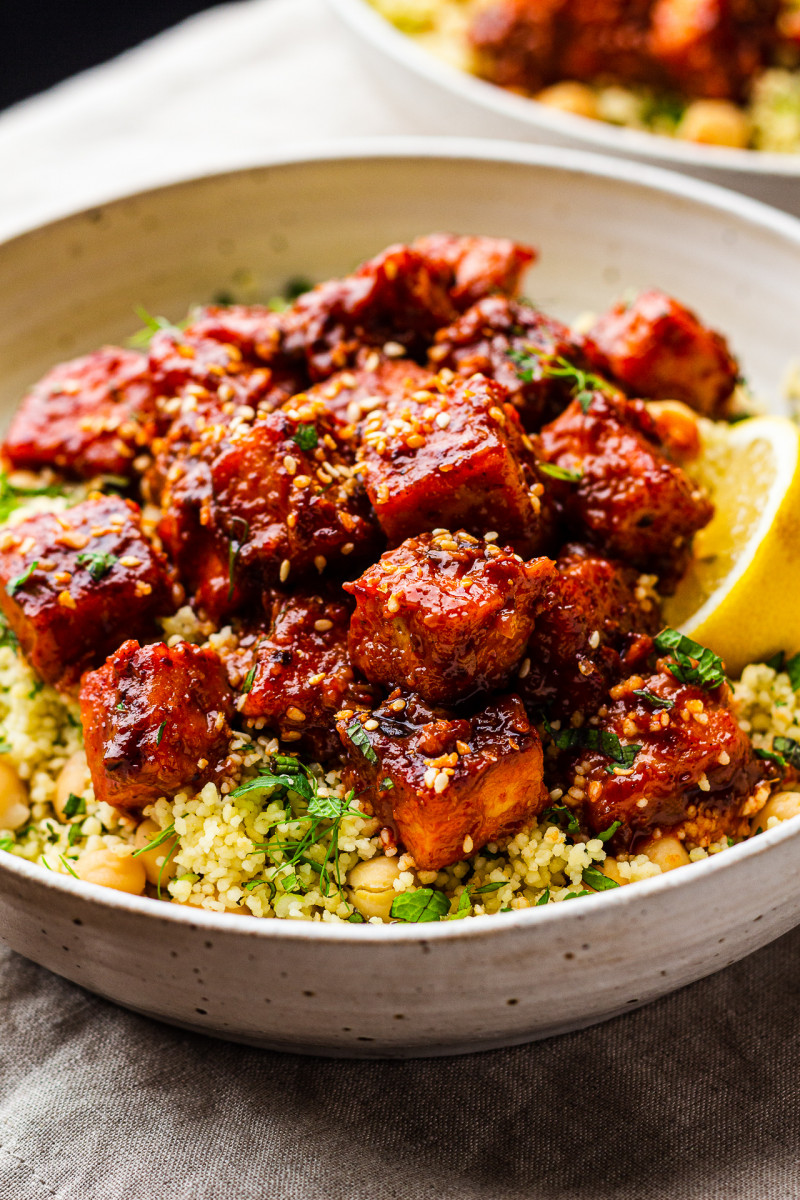
This glossy and sticky harissa tofu bowl is inspired by one of my earlier recipes featuring another spicy condiment – Gochujang, Korean smoky chilli paste. A while ago I made sticky Gochujang tempeh paired with plain rice and a simple pickled slaw so I figured that taking that concept and playing with North African flavours instead, was a no brainer.
To make these harissa bowls, coat your tofu in cornstarch (I also like to season it first, but you can skip this extra step if you are in a rush) and fry until crispy. If you aren’t keen on frying, you can also bake it instead.
Once tofu has been cooked, combine sauce ingredients together and add them to the hot pan. The heat and a tiny bit of cornstarch will turn this sauce into a delicious shiny glaze in which you want to bathe your cooked tofu. That’s it, it’s really quite simple. You can have this tofu in a wrap or with a big green salad, some hummus and some flatbread or, like me, pair it with a simple herby couscous for a delicious main meal.
This harissa tofu bowl is beautifully glossy, sticky and spicy, but not too spicy. If you are sensitive to spice, however, be sure to take down the amount of harissa. Harissa is traditionally used in combination with honey and lemon so I seasoned the sauce – or the glaze more like – with maple syrup and lemon too. The glaze may taste a little strong on its own but once it gets combined with bland tofu and a simple herby couscous, it’s perfect. At least my husband – who has had an emotional week due to Australia losing at cricket, he says – loved it so I hope you’ll enjoy it too.
MORE ABOUT THE INGREDIENTS
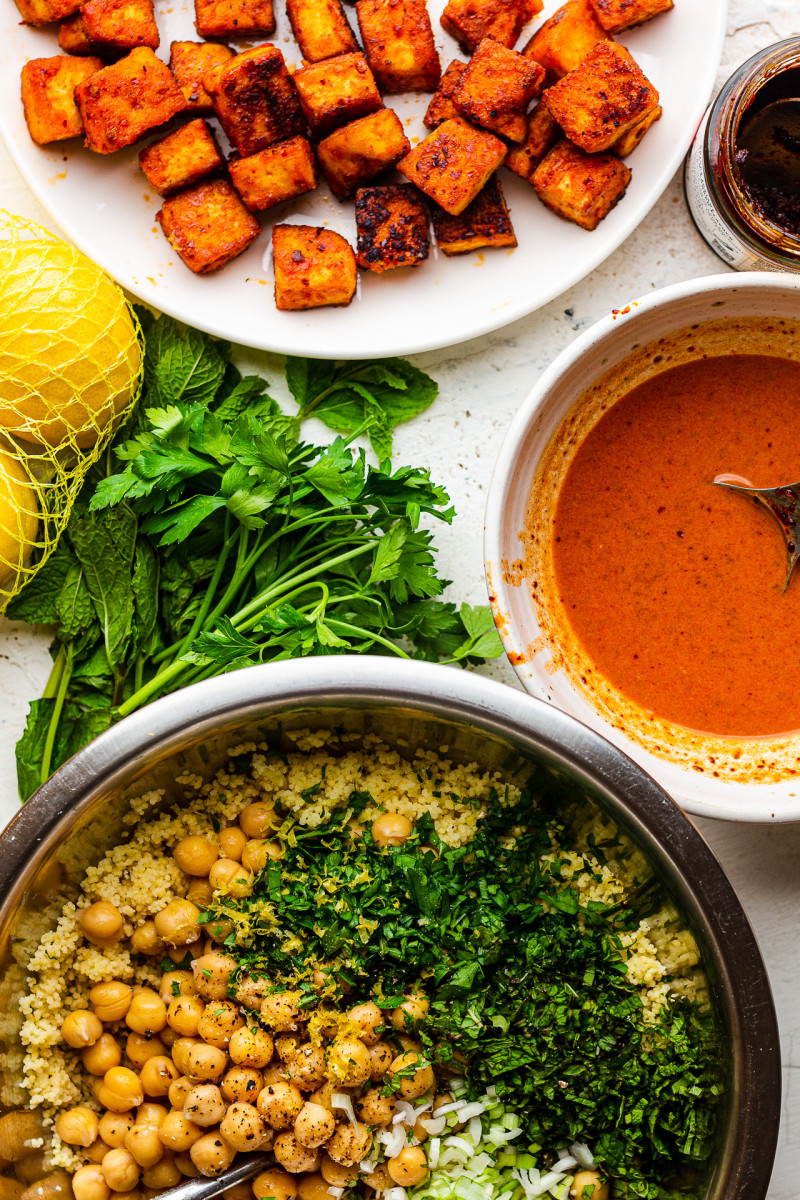
HARISSA PASTE: Harissa paste is a Tunisian chilli and spice paste that is used in several North African countries. Different brands have different strengths (I used Belazu smoked chilli one) so when you first make this dish, tread carefully. Having said that while the glaze tastes strong on its own, by the time it has coated all the tofu cubes, it has the right amount of flavour. If you overdo the spice by mistake, serve with some vegan yoghurt to moderate the heat.
GARLIC CLOVE: You could grate a clove of garlic straight into the marinade but I prefer to pan-fry it briefly to take its rawness out of it.
GINGER: You could grate some fresh ginger into the sauce, but I prefer to pan-fry it alongside the garlic, it only takes a minute or two and it mellows the flavour a lot.
MAPLE SYRUP: Harissa paste is often used in combination with honey to create marinades, dressings etc. so I opted for a bit of maple syrup to add some sweetness and stickiness to this spicy, harissa-flavoured glaze.
VEGAN CREAM: In order to bulk up the sauce and make it creamier and a little mellower, I added a good splash vegan cream to it. I went for Oatly single cream as I always have that in my fridge but you could use something similar instead.
LEMON ZEST & JUICE: For this recipe, you’ll need both lemon zest and lemon juice. I use a bit of lemon juice in the glaze to balance the sweetness of maple syrup and some more to flavour my couscous. Couscous also benefits from ample lemon zest so nothing gets wasted. Be sure to buy unwaxed lemons and to scrub them well before before zesting.
FIRM TOFU: You want a packet of firm or extra firm tofu in this recipe. I used a packet of already pressed tofu (Tofoo) for ease, but you can also use regular tofu and press it yourself.
CORNSTARCH: A thin layer of cornstarch (cornflour in the UK) helps to make tofu crispy when frying it. I also used a tiny bit more, diluted with water, to help the glaze thicken at the end.
COUSCOUS: I paired my harissa tofu with couscous as it’s super quick to prepare (requires no cooking) and filling. You prepare it by simply pouring some boiling water over it, covering it and letting it absorb all of the water and cook in the resulting steam. Couscous isn’t gluten-free, so if you are after a gluten-free equivalent how about quinoa or brown rice.
SPRING ONIONS: A couple of spring onions (scallions) add a subtle savoury flavour to the couscous. I cut them lengthwise into a few strips and then chop finely as I want the pieces to be as small as possible but slicing them thinly is fine too, of course. You could also use half an onion, red one ideally. If you do want to use an onion, I would recommend dicing it very finely and submerging it in boiling water for a few minutes to take the harshness out.
SPICES: I flavoured the tofu with a dusting of smoked paprika and cumin while seasoning it. You can skip this step if you are short on time, I do it because I like my tofu to be seasoned throughout.
HERBS: I used two different herbs to flavour the couscous, parsely and mint. You could use coriander (cilantro) instead of parsley if you prefer. When using mint, you need to pick the leaves and chop them finely, but when it comes to parsley all you need to do is get rid of the large stems, fine stems are okay to include.
CHICKPEAS: To make this dish even more filing and protein-rich, I added a can of drained chickpeas to the couscous. If you don’t like chickpeas, you could go with firm (like Puy) lentils instead.
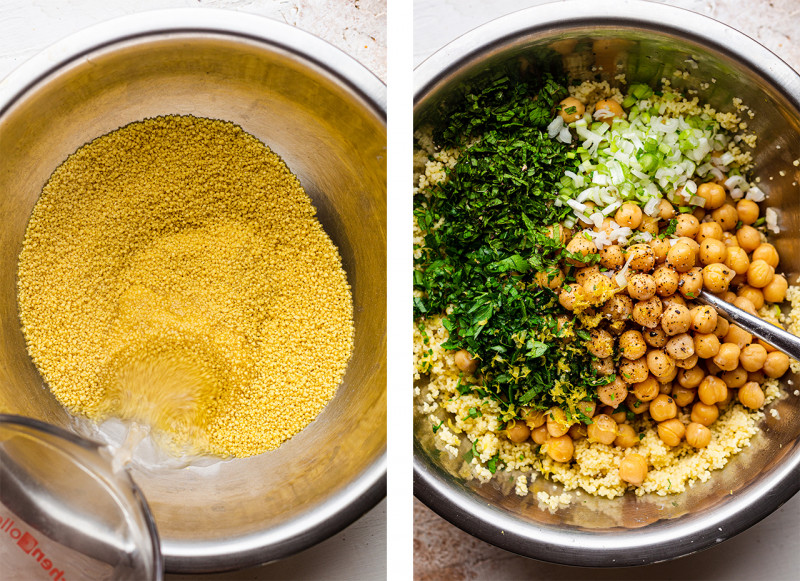
First up make the couscous by covering it with boiling water and setting aside. Chop up all the remaining herby couscous ingredients, but don’t mix them in until your couscous has cooled down and the heat of the couscous will make the herbs (especially mint) wilt and discolour.
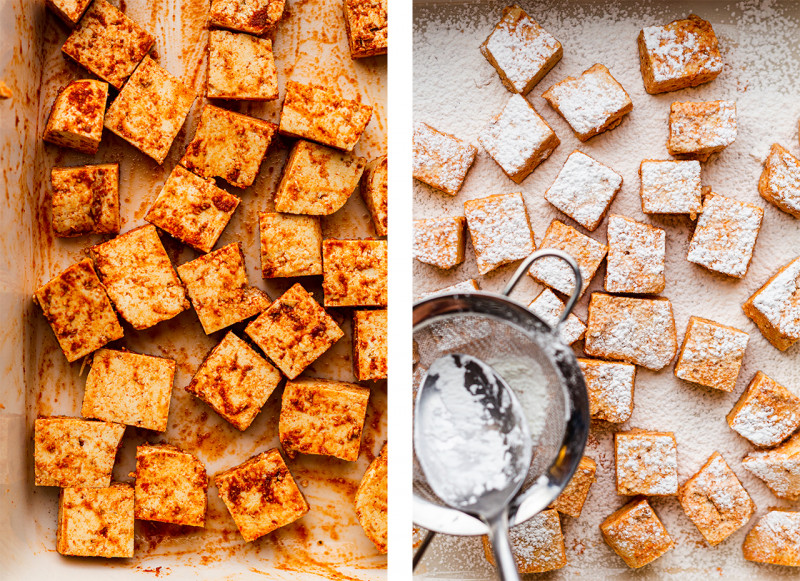
If you have the time, season the tofu with salt and some dry spices first otherwise skip this step. Just before you are ready to fry, coat tofu pieces in a thin layer of cornstarch. It helps it crisp up once in a frying pan.
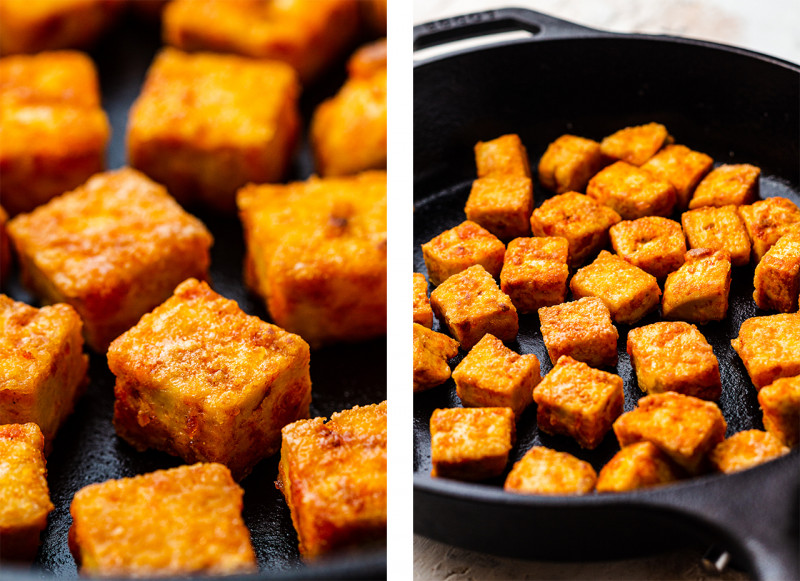
Pre-heat a bit of oil in a not stick pan and then add cornstarch coated tofu and fry until golden and crispy on all sides.
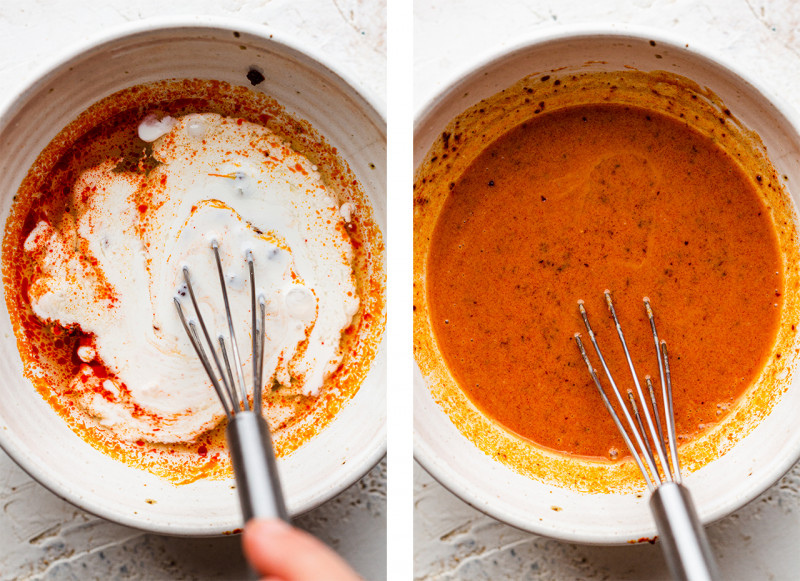
Make the glaze by combining harissa paste, maple syrup, lemon juice and single cream in a bowl or jug.
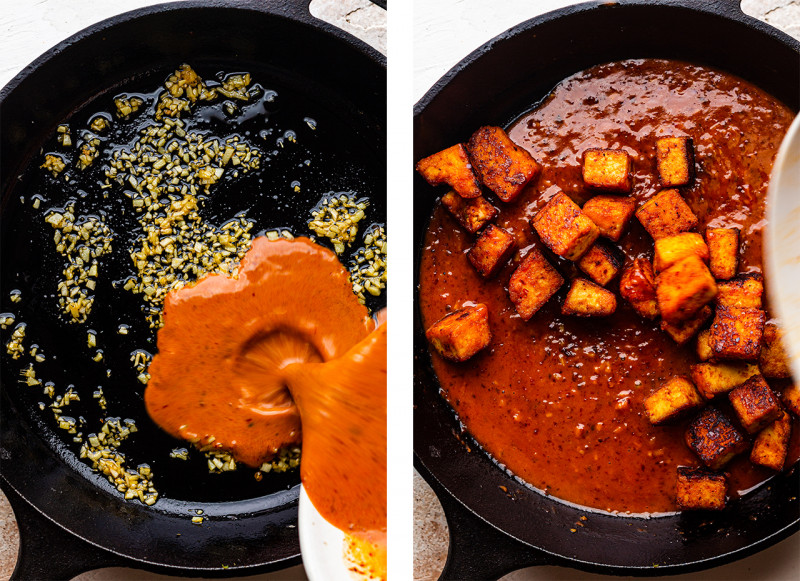
Remove tofu from the pan, return it to heat and add a bit more oil. Once heated up, pan-fry garlic and ginger gently for a few minutes, stirring frequently. Once opaque, add the sauce and cornstarch slurry, allow it to thicken a little before adding in fried tofu and stirring to coat.
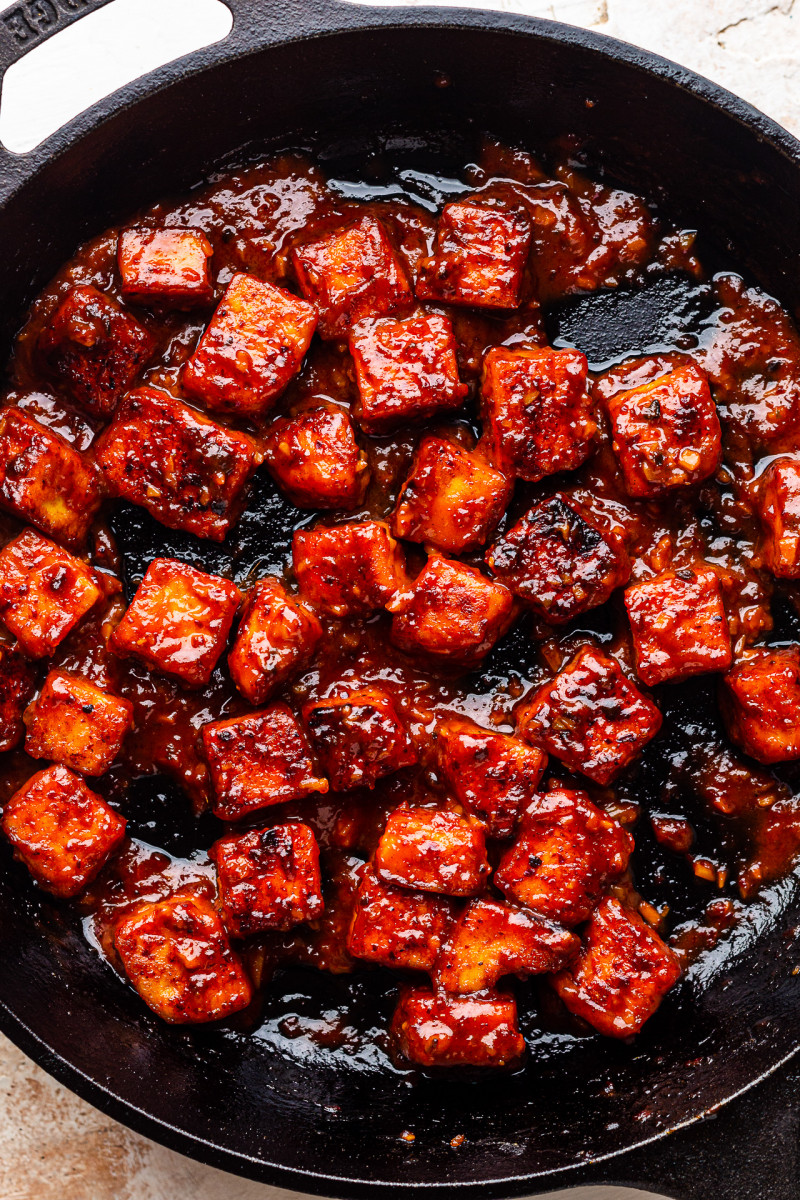
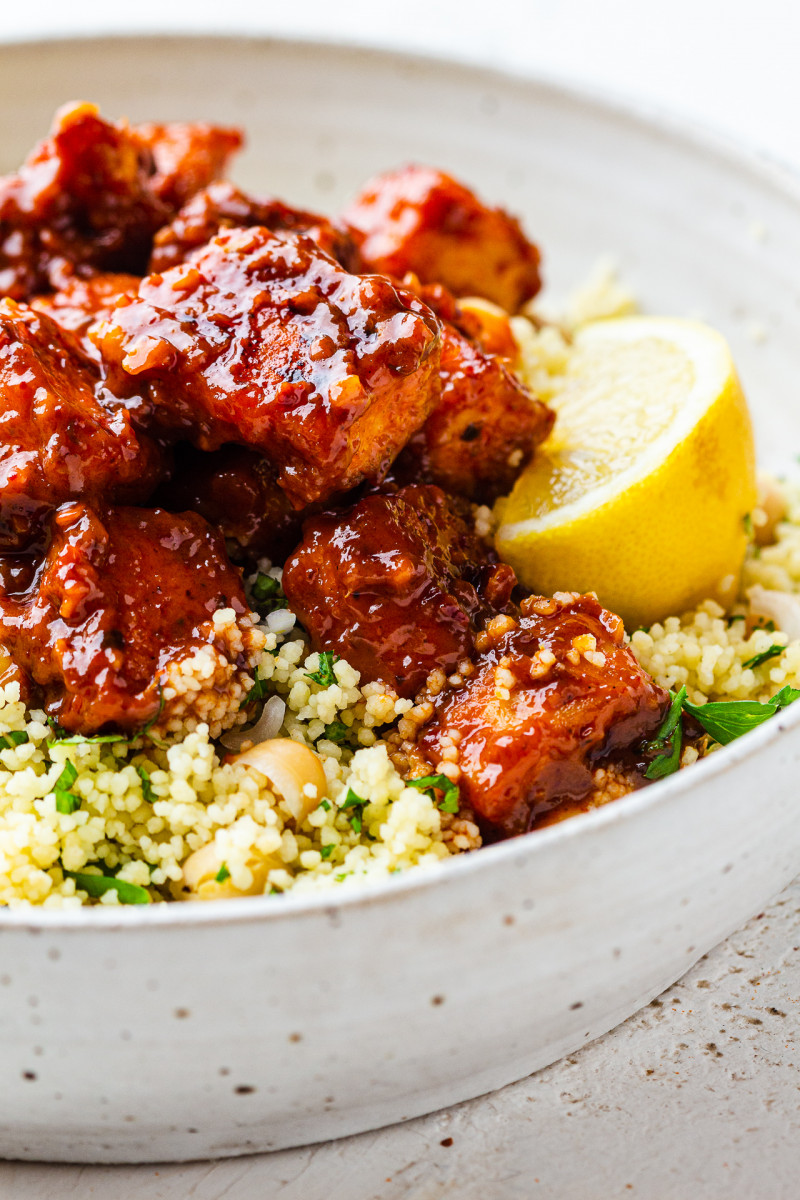
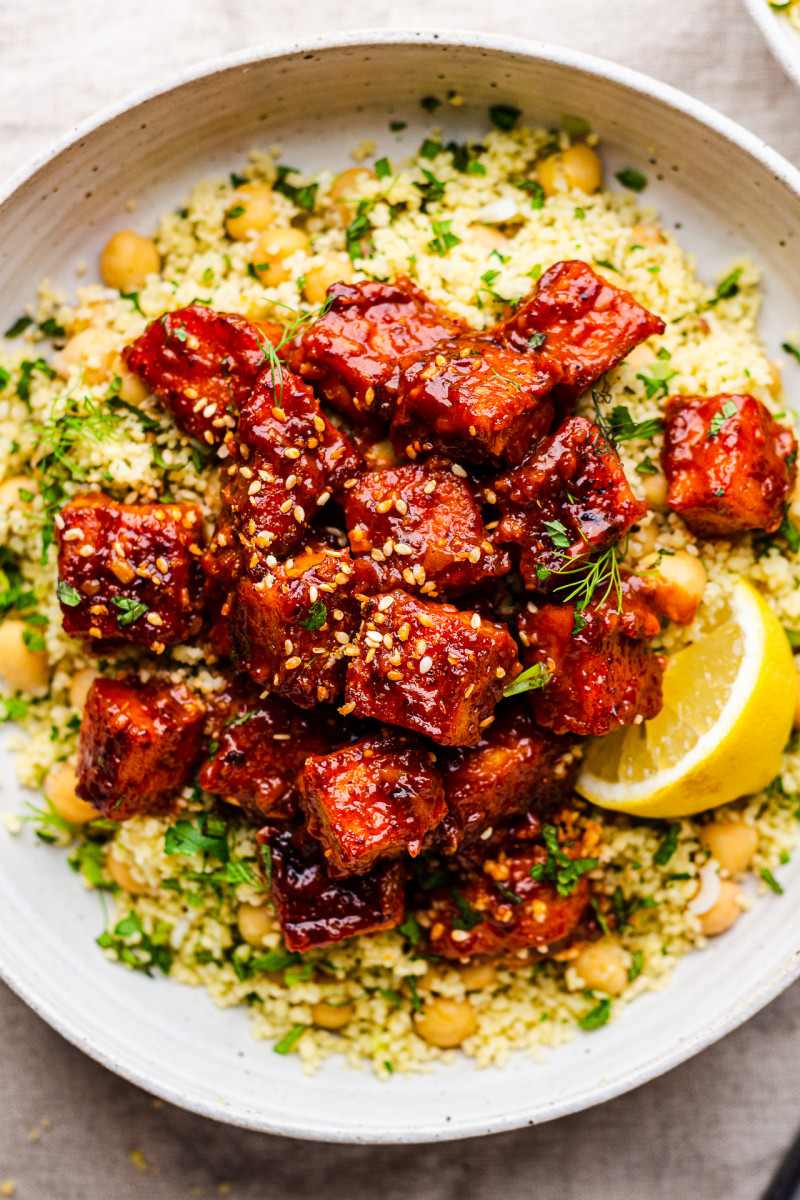
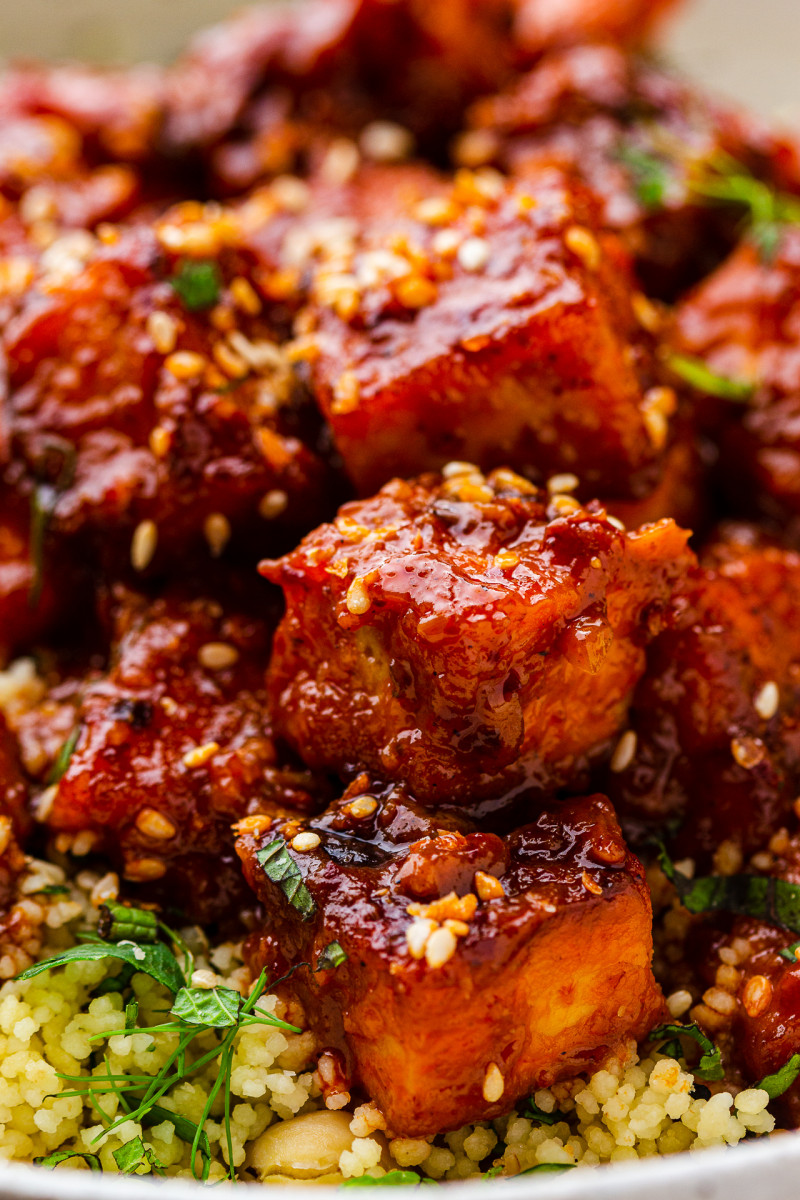
- 280 g / 10 oz ready-pressed tofu (I used Tofoo)*
- approx. 1 tsp salt, adjust to taste
- ½ tsp ground cumin (optional)
- ½ tsp smoked paprika (optional)
- 2 tbsp + ½ tsp cornstarch
- oil, for frying
- 30 ml / 2 tbsp harissa paste*
- 30 ml / 2 tbsp maple syrup
- 30 ml / 2 tbsp lemon juice, more to taste
- 80 ml / 1/3 cup vegan single cream (I used Oatly)
- 0.5″ / 1.5 cm ginger, finely minced
- 1 garlic clove, finely minced
HERBY COUSCOUS
- 135 g / 1½ cup couscous (or rice/quinoa* if GF)
- 15 ml / 1 tbsp olive oil
- 2 spring onions/scallions, finely sliced
- 400 g / 14 oz can of chickpeas, drained
- large handful of mint and parsley (or coriander)
- 1 lemon, zest and juice
- salt and pepper
HARISSA TOFU
- Cut your tofu into 2 cm / 0.8″ cubes. I used ready-pressed tofu, but be sure you press it first if you are using unpressed tofu.
- If you have time (you can skip this step and add a bit of salt to the cornstarch in next step), combine ½ of salt with a tablespoon of warm water, ½ tsp cumin and ½ tsp paprika in a shallow dish, add your tofu and stir to coat. Allow it to absorb the moisture while you make the couscous (see below).
- Coat tofu cubes in a thin layer of cornstarch (approx. 1-2 tbsp). Warm up 1 tbsp of frying oil in a well pre-heated non-stick skillet (or a wok). Arrange tofu on top and fry until golden on all sides. Instead of frying, you can also bake your tofu at 200° C / 390° F for about 30 minutes, until firm.
- Combine harissa paste, maple syrup, lemon juice (I like 3 tbsp), vegan cream and 2 tbsp of water in a jug. Season with salt (about ½ tsp tsp, adjust to taste). Combine ½ tsp of cornstarch with 1 tsp of water in a small bowl.
- Remove fried tofu from the skillet, add another tablespoon of oil and fry garlic and ginger on really low heat until opaque and fragrant. Add harissa sauce to the pan and diluted cornstarch, allow the sauce to bubble briefly just to thicken, then add fried tofu and stir to coat. Serve on top of herby couscous.
HERBY COUSCOUS
- Place and ½ tsp salt in a bowl. Pour 225 ml (scant cup) of boiling water over it then immediately cover with an upside down plate. Move on to the next step.
- Cut spring onions finely, pick mint leaves and parsley leaves (fine stalks are fine to include and chop finely), zest a lemon and set aside.
- Uncover the couscous, fluff it up and let it cool or else your herbs will wilt.
- Once your couscous is no longer warm, add chickpeas, chopped spring onions, herbs, lemon zest, olive oil and juice of half a lemon. Stir through well, adjust the seasoning if needed.
*HARISSA PASTE: the strength of shop-bought harissa pastes differs, authentic Tunisian pastes that often come in cans or tubes tend to be stronger so be sure to adjust the amount to taste. I used Smoked Chilli Harissa by Belazu, which is medium spicy and available in well-stocked UK supermarkets.
*QUINOA: if you want to keep this salad gluten-free, use quinoa or rice instead of couscous. I cook both using absorption method of 1 cup grain : 1¼ cup water ratio. I cook it covered on the lowest heat. Once all of the water has been absorbed, I switch the heat off but keep the lid on and let it steam for another 10 minutes.